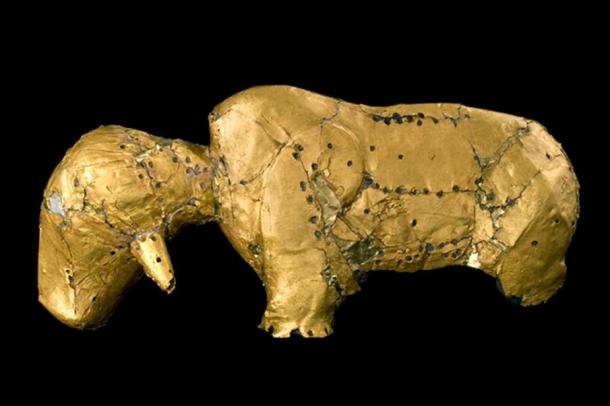South Africa’s National Gold Treasures Just Got Rarer
Gold has been prominent in human thought and history for over 6,000 years. Considered by some, to be one of earth’s rarest and most valued precious metals, it has gained a peculiar, and indeed, an inimitable place in human history. From time immemorial, the color of gold and its enduring qualities as a precious metal, have appealed to human nature throughout ancient times to the present. However, there is much more to gold than simply color and shiny luster. Gold remains what it has always been, a substance which is precious because it is rare and in this case, archaeologically unique.

Gold bovine figurine from the Mapungubwe Collection (CC Department of UP Arts, University of Pretoria)
Rarity of Archaeological Gold
Although today gold is surprisingly found in large quantities in South Africa, archaeological gold is truly a rarity. This unique precious metal has always been avidly sought, skillfully worked and jealously guarded by those who made it, those who valued it, centuries later by those who excavated it and today those who protect it. The Mapungubwe archaeological gold collection is famously known for the scientific discovery in 1933 of a small gold rhinoceros figurine, presumably one of the most important archaeological artifacts ever discovered in South Africa and as a result uncovering southern Africa’s first known state or kingdom (1220 – 1290 AD). This now famous gold figurine together with a multitude of other gold foil forms such as a gold specter, gold bovine and a gold vessel, as well as an array of jewelry in the form of gold beads, anklets and bangles, constitute the largest gold assemblage to South African archaeology.
Grand Theft of Thulamela Gold
The second largest archaeological gold collection was found more recently in 1997, at a site known as Thulamela that was occupied around the 1400 to 1700 AD. A midden area of the site yielded gold beads as well as two royal burials excavated contained gold beads, gold necklaces, gold wire, a gold bracelet, several gold foil fragments and gold droplets. Sadly, widely reported in the media, this archaeological gold collection was stolen from the public exhibition from the Stevenson-Hamilton Knowledge Resource Centre & Museum in Skukuza in the Kruger National Park, a museum under the jurisdiction of South African National Parks. The loss of this unique heritage is a major setback for South African archaeology.
Like this Preview and want to read on? You can! JOIN US THERE ( with easy, instant access ) and see what you’re missing!! All Premium articles are available in full, with immediate access.
For the price of a cup of coffee, you get this and all the other great benefits at Ancient Origins Premium. And - each time you support AO Premium, you support independent thought and writing.
Extracted from Tiley-Nel, S L. 2017. National Treasures. The Mapungubwe Gold Collection of the University of Pretoria. Exhibition catalogue. Department of UP Arts, University of Pretoria: Pretoria. Images permission granted by Department of UP Arts University of Pretoria. Sale enquiries: e-mail: [email protected]
Sian Tiley-Nel is a South African Chief Curator with a specialized PhD interest in historical and contested archives and heritage conservation. She currently manages the University of Pretoria Museums and serves a Chief Curator of the Mapungubwe Collection.
Top Image: The Mapungubwe Gold Rhinoceros. (CC. Department of UP Arts, University of Pretoria)



















